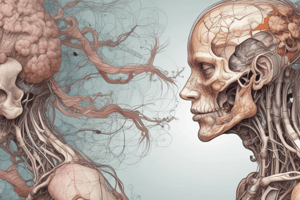Podcast
Questions and Answers
What is the basic unit of life?
What is the basic unit of life?
- Cell (correct)
- Tissue
- Organ
- Organ System
The coronal plane divides the body into superior and inferior parts.
The coronal plane divides the body into superior and inferior parts.
False (B)
What term describes the body’s ability to maintain stable internal conditions despite external changes?
What term describes the body’s ability to maintain stable internal conditions despite external changes?
Homeostasis
The ______ system is responsible for transporting nutrients, gases, hormones, and waste.
The ______ system is responsible for transporting nutrients, gases, hormones, and waste.
Match the following types of body tissues with their primary functions:
Match the following types of body tissues with their primary functions:
Which of the following correctly describes catabolism?
Which of the following correctly describes catabolism?
Positive feedback mechanisms work to counteract changes in the body.
Positive feedback mechanisms work to counteract changes in the body.
Identify the two primary cavities of the ventral body cavity.
Identify the two primary cavities of the ventral body cavity.
The structure of the lungs, particularly the ______, maximizes gas exchange efficiency.
The structure of the lungs, particularly the ______, maximizes gas exchange efficiency.
Which organ system regulates bodily functions through hormones?
Which organ system regulates bodily functions through hormones?
Flashcards are hidden until you start studying
Study Notes
Anatomy
-
Definition: The study of the structure of the body and its parts.
-
Levels of Organization:
- Cells: Basic unit of life.
- Tissues: Groups of similar cells performing a common function.
- Types: Epithelial, connective, muscle, nervous.
- Organs: Composed of two or more types of tissues.
- Organ Systems: Groups of organs working together (e.g., digestive system, respiratory system).
- Organism: Complete living entity.
-
Body Planes:
- Sagittal Plane: Divides the body into left and right.
- Coronal Plane: Divides the body into anterior (front) and posterior (back).
- Transverse Plane: Divides the body into superior (upper) and inferior (lower).
-
Body Cavities:
- Dorsal Cavity: Contains the cranial and spinal cavities.
- Ventral Cavity: Divided into the thoracic cavity (heart, lungs) and abdominopelvic cavity (digestive organs, reproductive organs).
Physiology
-
Definition: The study of the functions of the body's systems and their parts.
-
Key Concepts:
- Homeostasis: The body’s ability to maintain stable internal conditions despite external changes.
- Metabolism: The sum of all chemical reactions in the body, including:
- Catabolism: Breaking down molecules for energy.
- Anabolism: Building up molecules for growth and repair.
-
Organ System Functions:
- Circulatory System: Transports nutrients, gases, hormones, and waste.
- Respiratory System: Facilitates gas exchange (oxygen and carbon dioxide).
- Digestive System: Breaks down food, absorbs nutrients, and eliminates waste.
- Nervous System: Controls and coordinates body activities through electrical signals.
- Endocrine System: Regulates bodily functions through hormones.
-
Feedback Mechanisms:
- Positive Feedback: Enhances or accelerates changes (e.g., childbirth).
- Negative Feedback: Counteracts changes to maintain balance (e.g., blood glucose regulation).
Interaction Between Anatomy and Physiology
- Structure determines function; the anatomy of a cell or organ influences how it works.
- E.g., the structure of the lungs (alveoli) maximizes gas exchange efficiency.
Importance of Study
- Understanding anatomy and physiology is crucial for medical and health-related fields.
- Aids in diagnosing diseases, understanding treatments, and promoting health.
Anatomy
- Definition: Involves the examination of the body's structure and its components.
- Levels of Organization:
- Cells: Fundamental unit of life.
- Tissues: Collections of similar cells working together; classified into four main types:
- Epithelial: Covers body surfaces and lines cavities.
- Connective: Supports and binds other tissues.
- Muscle: Responsible for body movement.
- Nervous: Transmits signals and processes information.
- Organs: Structures made of multiple tissue types functioning together.
- Organ Systems: Groups of organs that collaborate for specific roles, such as the digestive and respiratory systems.
- Organism: An entire living being composed of various organ systems.
- Body Planes:
- Sagittal Plane: Divides the body into left and right sections.
- Coronal Plane: Divides the body into anterior (front) and posterior (back) segments.
- Transverse Plane: Divides the body into superior (upper) and inferior (lower) portions.
- Body Cavities:
- Dorsal Cavity: Encloses the cranial cavity (brain) and spinal cavity (spine).
- Ventral Cavity: Further divided into:
- Thoracic Cavity: Contains the heart and lungs.
- Abdominopelvic Cavity: Houses digestive and reproductive organs.
Physiology
- Definition: Focuses on how the body's systems and their components function.
- Key Concepts:
- Homeostasis: The maintenance of stable internal conditions regardless of external factors.
- Metabolism: Encompasses all chemical reactions, distinguishing between:
- Catabolism: The breakdown of molecules for energy release.
- Anabolism: The synthesis of compounds for growth and repair.
- Organ System Functions:
- Circulatory System: Delivers nutrients, gases, hormones, and removes waste.
- Respiratory System: Enables the exchange of gases (oxygen uptake and carbon dioxide removal).
- Digestive System: Processes food to extract nutrients and eliminate waste.
- Nervous System: Oversees and coordinates bodily functions via electrical signals.
- Endocrine System: Governs processes using hormones as regulatory substances.
- Feedback Mechanisms:
- Positive Feedback: Accelerates processes (e.g., the enhancement of uterine contractions during childbirth).
- Negative Feedback: Diminishes changes to maintain equilibrium (e.g., regulating blood glucose levels).
Interaction Between Anatomy and Physiology
- The relationship between structure and function: The design of a cell or organ inherently influences its operational capabilities.
- Example: The specialized structure of lung alveoli facilitates efficient gas exchange due to their large surface area.
Importance of Study
- An in-depth understanding of anatomy and physiology is essential for professions in medical and health fields.
- It contributes to disease diagnosis, comprehension of treatment options, and the promotion of overall health.
Studying That Suits You
Use AI to generate personalized quizzes and flashcards to suit your learning preferences.




